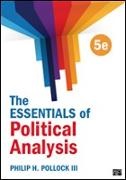Read more
Informationen zum Autor Philip H. Pollock III is professor of political science at the University of Central Florida. He has taught courses in research methods at the undergraduate and graduate levels for nearly 30 years. His main research interests are American public opinion, voting behavior, techniques of quantitative analysis, and the scholarship of teaching and learning. His recent research has been on the effectiveness of Internet-based instruction. Pollock's research has appeared in the American Journal of Political Science, Social Science Quarterly, and British Journal of Political Science. Recent scholarly publications include articles in Political Research Quarterly, the Journal of Political Science Education, and PS: Political Science and Politics. Klappentext "Overall, this is the best political science research methods book I've seen." -William Field, Rutgers University Building students' analytic abilities and developing their statistical reasoning with new data, fresh exercises, and engaging examples, this accessible introduction to the essential elements of political analysis walks students through the basics-measuring concepts, describing variables, formulating and testing hypotheses, controlling for alternative explanations, and interpreting graphic displays, and nearly 50 practical exercises motivate them to use their new skills with confidence. New to this edition: All examples updated with current data sources Treatment of visual depictions of variables and relationships and enhanced coverage of logistic regression A total of 48 end-of-chapter exercises, many new or completely revised More accessible discussion of spurious, additive, and interaction relationships Coverage of box plots and error bar charts New discussion of ways to represent probabilities in logistic regression Zusammenfassung Equipping students with the skills needed to do political analysis and critically assess statistical research, this Fifth Edition has been updated with new data sources, coverage of box plots and error bar charts, and looks at visual depictions of variables. Inhaltsverzeichnis Introduction What This Book Is About Facts and Values in Perspective The Scientific Approach Conclusion Chapter 1: The Definition and Measurement of Concepts Conceptual Definitions Operational Definitions Summary Key Terms Exercises Chapter 2: Measuring and Describing Variables Measuring Variables Describing Variables Summary Key Terms Exercises Chapter 3: Proposing Explanations, Framing Hypotheses, and Making Comparisons Proposing Explanations Framing Hypotheses Making Comparisons Graphing Relationships and Describing Patterns Summary Key Terms Exercises Chapter 4: Research Design and the Logic of Control Experimental Designs Controlled Comparisons Three Scenarios Summary Key Terms Exercises Chapter 5: Making Controlled Comparisons Cross-tabulation Analysis Graphing Controlled Comparisons An Example of Interaction Mean Comparison Analysis Summary Key Terms Exercises Chapter 6: Foundations of Statistical Inference Population Parameters and Sample Statistics Random Sampling The Standard Error of a Sample Mean Inference Using the Normal Distribution Inference Using the Student's t-Distribution What About Sample Proportions? Summary Key Terms Exercises Chapter 7: Tests of Significance and Measures of Association Statistical Significance Measures of Association Summary Key Terms Exercises Chapter 8: Correlation and Linear Regression Correlation Bivariate Regression R-square Dummy Variable Regression Multiple Re...

